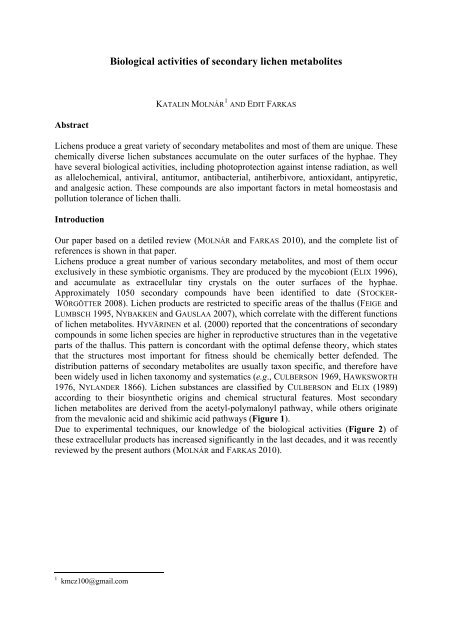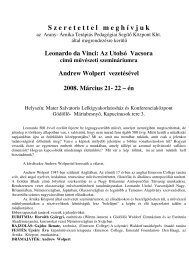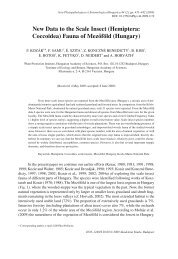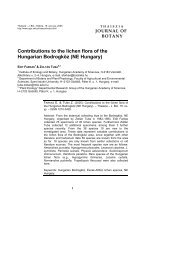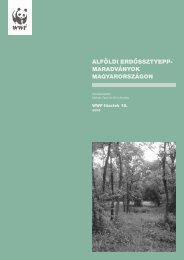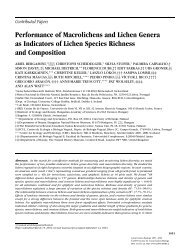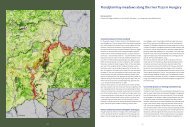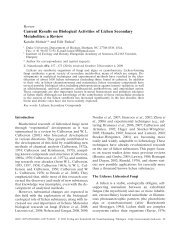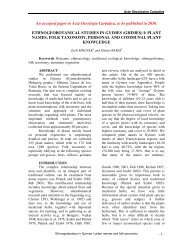Biological activities of secondary lichen metabolites
Biological activities of secondary lichen metabolites
Biological activities of secondary lichen metabolites
Create successful ePaper yourself
Turn your PDF publications into a flip-book with our unique Google optimized e-Paper software.
<strong>Biological</strong> <strong>activities</strong> <strong>of</strong> <strong>secondary</strong> <strong>lichen</strong> <strong>metabolites</strong>KATALIN MOLNÁR 1 AND EDIT FARKASAbstractLichens produce a great variety <strong>of</strong> <strong>secondary</strong> <strong>metabolites</strong> and most <strong>of</strong> them are unique. Thesechemically diverse <strong>lichen</strong> substances accumulate on the outer surfaces <strong>of</strong> the hyphae. Theyhave several biological <strong>activities</strong>, including photoprotection against intense radiation, as wellas allelochemical, antiviral, antitumor, antibacterial, antiherbivore, antioxidant, antipyretic,and analgesic action. These compounds are also important factors in metal homeostasis andpollution tolerance <strong>of</strong> <strong>lichen</strong> thalli.IntroductionOur paper based on a detiled review (MOLNÁR and FARKAS 2010), and the complete list <strong>of</strong>references is shown in that paper.Lichens produce a great number <strong>of</strong> various <strong>secondary</strong> <strong>metabolites</strong>, and most <strong>of</strong> them occurexclusively in these symbiotic organisms. They are produced by the mycobiont (ELIX 1996),and accumulate as extracellular tiny crystals on the outer surfaces <strong>of</strong> the hyphae.Approximately 1050 <strong>secondary</strong> compounds have been identified to date (STOCKER-WÖRGÖTTER 2008). Lichen products are restricted to specific areas <strong>of</strong> the thallus (FEIGE andLUMBSCH 1995, NYBAKKEN and GAUSLAA 2007), which correlate with the different functions<strong>of</strong> <strong>lichen</strong> <strong>metabolites</strong>. HYVÄRINEN et al. (2000) reported that the concentrations <strong>of</strong> <strong>secondary</strong>compounds in some <strong>lichen</strong> species are higher in reproductive structures than in the vegetativeparts <strong>of</strong> the thallus. This pattern is concordant with the optimal defense theory, which statesthat the structures most important for fitness should be chemically better defended. Thedistribution patterns <strong>of</strong> <strong>secondary</strong> <strong>metabolites</strong> are usually taxon specific, and therefore havebeen widely used in <strong>lichen</strong> taxonomy and systematics (e.g., CULBERSON 1969, HAWKSWORTH1976, NYLANDER 1866). Lichen substances are classified by CULBERSON and ELIX (1989)according to their biosynthetic origins and chemical structural features. Most <strong>secondary</strong><strong>lichen</strong> <strong>metabolites</strong> are derived from the acetyl-polymalonyl pathway, while others originatefrom the mevalonic acid and shikimic acid pathways (Figure 1).Due to experimental techniques, our knowledge <strong>of</strong> the biological <strong>activities</strong> (Figure 2) <strong>of</strong>these extracellular products has increased significantly in the last decades, and it was recentlyreviewed by the present authors (MOLNÁR and FARKAS 2010).1 kmcz100@gmail.com
Figure 1. Biosynthetic pathways <strong>of</strong> <strong>lichen</strong> <strong>secondary</strong> <strong>metabolites</strong> [modified from ELIX andSTOCKER-WÖRGÖTTER (2008)].Figure 2. Lichen substances have several biological <strong>activities</strong>.
Antioxidant activityFree radicals play an important role in many chemical processes in the cells, but they are alsoassociated with unwanted side effects, causing cell damage. Since synthetic antioxidants are<strong>of</strong>ten carcinogenic, finding natural substitutes is <strong>of</strong> great interest. Lichens have been found tocontain a variety <strong>of</strong> <strong>secondary</strong> <strong>lichen</strong> substances, which are strong antioxidant compounds.According to LUO et al. (2009), the extreme conditions in Antarctica increase oxidativestress, consequently, Antarctic <strong>lichen</strong>s contain larger amounts <strong>of</strong> antioxidant substances andhave higher antioxidant activity than tropical or temperate <strong>lichen</strong>s.AMO de PAZ et al. (2010) reported that methanol extracts <strong>of</strong> Xanthoparmelia camtschadalisand X. conspersa (Figure 3.), as well as their isolated <strong>lichen</strong> compounds (salazinic acid,stictic acid, and usnic acid) protected human astrocytes from hydrogen peroxide-induceddamage. Astrocytes are the first line <strong>of</strong> defense in the brain against neurotoxicity <strong>of</strong> reactiveoxygen species (ROS), thus salazinic acid, stictic acid, and usnic acid could act as antioxidantagents in those neurodegenerative disorders associated with oxidative damage (e.g.,Alzheimer’s disease and Parkinson’s disease).Figure 3. Xanthoparmelia conspersa contains the β-orcinol depsidone stictic acid as major<strong>lichen</strong> compound in the medulla. This antioxidant <strong>lichen</strong> substance plays an important role inthe protection against oxidative stress.Effect on metal homeostasis and pollution toleranceLichen <strong>secondary</strong> <strong>metabolites</strong> are sensitive to heavy metal accumulation and might play ageneral role in metal homeostasis and pollution tolerance. According to BIAŁONSKA andDAYAN (2005) the levels <strong>of</strong> atranorin, physodic acid and hydroxyphysodic acid significantlydecreased in thalli <strong>of</strong> Hypogymnia physodes transplanted to the vicinity <strong>of</strong> a chemical plantproducing chromium, phosphorous and sulfur compounds. In contrast, the level <strong>of</strong> physodalicacid increased significantly, suggesting that this compound might be effective againstpollution stress.Usnic acid and divaricatic acid were both found to significantly increase the intracellularuptake <strong>of</strong> Cu 2+ in Evernia mesomorpha and in Ramalina menziesii (usnic acid only) (HAUCKet al. 2009), but intracellular uptake <strong>of</strong> Mn 2+ was reduced. The influence <strong>of</strong> the compoundsfacilitate the survival <strong>of</strong> the two <strong>lichen</strong> species.
PhotoprotectionLichens use a number <strong>of</strong> strategies to protect the light-sensitive algal symbionts against highlevels <strong>of</strong> light and the damaging effects <strong>of</strong> UV radiation, e.g., light screening and UV-Bprotection by <strong>lichen</strong> compounds. The light-screening theory was formulated by ERTL (1951),who found that cortical <strong>lichen</strong> compounds increase the opacity <strong>of</strong> the upper cortex, and thusdecrease high incident irradiance reaching the algal layer. Light screening cortical pigments(such as parietin, usnic acid, vulpinic acid) regulate solar irradiance reaching the algal layer(GALLOWAY 1993, SOLHAUG and GAUSLAA 1996, see also FARKAS 2007) by absorbing much<strong>of</strong> the incident light and thus protecting the photosynthetic partner against intense radiation(RAO and LEBLANC 1965) (Figure 4). UV-B inhibits photosynthesis and damages DNA.Several <strong>lichen</strong> <strong>secondary</strong> <strong>metabolites</strong> (including atranorin, calycin, pinastric acid, rhizocarpicacid, usnic acid, vulpinic acid) have strong UV absorption abilities and might function asfilters for excessive UV-B irradiation (RUNDEL 1978, SOLHAUG and GAUSLAA 1996).Figure 4. The anthraquinone parietin is an orange cortical pigment and widespread inTeloschistaceae, thus also occurs in Xanthoria parietina. Parietin protects thephotosynthetic apparatus <strong>of</strong> the photobiont against intense radiation.AllelopathyLichen <strong>secondary</strong> <strong>metabolites</strong> can function as allelopathic agents, i.e., they may affect thedevelopment and growth <strong>of</strong> neighboring <strong>lichen</strong>s, fungi, mosses and vascular plants, as well asmicroorganisms (LAWREY 1995, MACÍAS et al. 2007, ROMAGNI et al. 2004, RUNDEL 1978).Competition occurs between <strong>lichen</strong> thalli for space and light on a variety <strong>of</strong> substrates, andplays important roles in determining the structure <strong>of</strong> <strong>lichen</strong> communities and the distribution<strong>of</strong> individual species (ARMSTRONG and WELCH 2007). Lichen <strong>secondary</strong> chemistry mightplay a role in this competition (ARMSTRONG and WELCH 2007).Antimicrobial activityAtranorin, fumarprotocetraric acid, gyrophoric acid, lecanoric acid, physodic acidprotocetraric acid, stictic acid and usnic acid showed relatively strong antimicrobial effectsagainst six bacteria and ten fungi, among which were human, animal and plant pathogens,mycotoxin-producers and food-spoilage organisms (RANKOVIĆ and MIŠIĆ 2008). Since
microorganisms have developed resistance to many antibiotics, pharmacologists need topursue new sources for antimicrobial agents. All these results suggest that <strong>lichen</strong>s and their<strong>metabolites</strong> yield significant new bioactive substances for the treatment <strong>of</strong> various diseasescaused by microorganisms.Antiherbivore activityLichens are grazed by herbivores, e.g., insects, mites, snails, slugs. However, herbivory on<strong>lichen</strong>s seems to be rare, presumably due to their low nutritional quality, specific structuralfeatures and the production <strong>of</strong> defense compounds (NIMIS and SKERT 2006, PÖYKKÖ et al.2005). It is known that natural plant-derived products have a less detrimental impact on theenvironment than synthetic chemicals, and thus <strong>lichen</strong> substances could be good candidatesfor new pesticides (DAYAN and ROMAGNI 2001).Cytotoxic, antitumor, and antiviral activityMany <strong>lichen</strong> <strong>secondary</strong> <strong>metabolites</strong> exhibit cytotoxic and antiviral properties and could bepotential sources <strong>of</strong> pharmaceutically useful chemicals.Human Papilloma Virus can cause cervical cancer. Due to clinical experiments, the adjuvanttreatment with usnic acid and zinc sulphate after radiosurgery promotes reepithelization andreduces recurrence (SCIRPA et al. 1999). Usnic acid decreases proliferation <strong>of</strong> human breastcancer cells and human lung cancer cells without any DNA damage (MAYER et al. 2005),accordingly, it may represent a novel source for a natural non-genotoxic anticancer drug(chemotherapeutic agent).Allergy to <strong>lichen</strong> substancesLichen substances can be contact allergens (e.g., atranorin, lobaric acid, stictic acid). Theycan cause occupational allergic contact dermatitis in forestry and horticultural workers(“woodcutter’s eczema”), as well as cause non-occupational allergic dermatitis during allkinds <strong>of</strong> outdoor <strong>activities</strong>, such as cutting firewood, hunting, and using cosmetics (perfumes,after-shave lotions, sunscreen products) that contain <strong>lichen</strong> <strong>metabolites</strong> (AALTO-KORTE et al.2005). Various skin and respiratory symptoms have been observed, such as erythema, itching,scaling, contact urticaria, rhinitis, and asthma (AALTO-KORTE et al. 2005, MITCHELL andCHAMPION 1965).Candidates for antipyretic and analgesic drugsSome <strong>lichen</strong> substances have been shown to relieve pain effectively or reduce fever andinflammation in various mammals, and it is reasonable to assume that these compounds alsocould be effective in humans. VIJAYAKUMAR et al. (2000) reported that usnic acid, isolatedfrom Roccella montagnei, showed significant anti-inflammatory activity in rats. Diffractaicand usnic acids have an analgesic effect in mice in vitro (OKUYAMA et al. 1995), and usnicacid also is an antipyretic.ConclusionsMore than 1000 <strong>secondary</strong> products have been identified to date in <strong>lichen</strong>s, and newcompounds will certainly be found from poorly studied or newly discovered <strong>lichen</strong>s,especially from the under-collected tropics. Furthermore, development in analitical
techniques will result in the more complete knowledge <strong>of</strong> the biological <strong>activities</strong> <strong>of</strong> <strong>lichen</strong><strong>secondary</strong> substances, as well as their role in <strong>lichen</strong> symbiosis.AcknowledgementsThe preparation <strong>of</strong> this paper was supported by the Hungarian Scientific Research Fund(OTKA T047160 and K81232).ReferencesReferences not listed here can be found in MOLNÁR and FARKAS (2010).AMO de PAZ G., RAGGIO J., GÓMEZ-SERRANILLOS M. P., PALOMINO O. M., GONZÁLEZ-BURGOS E., CARRETERO M. E., CRESPO A. 2010: HPLC isolation <strong>of</strong> antioxidantconstituents from Xanthoparmelia spp. Journal <strong>of</strong> Pharmaceutical and BiomedicalAnalysis 53: 165–171.CULBERSON W. L. 1969: The use <strong>of</strong> chemistry in the systematics <strong>of</strong> the <strong>lichen</strong>s. Taxon 18:152–166.CULBERSON C. F., ELIX J. A. 1989: Lichen substances. In: DEY P. M., HARBORNE J. B.(eds.): Methods in plant biochemistry, Vol. 1. Plant phenolics. Academic Press,London, pp. 509–535.ELIX J. A. 1996: Biochemistry and <strong>secondary</strong> <strong>metabolites</strong>. In: NASH T. H. III (eds.): Lichenbiology, 1st ed.. Cambridge University Press, pp. 155–180.ELIX J. A., STOCKER-WÖRGÖTTER E. 2008: Biochemistry and <strong>secondary</strong> <strong>metabolites</strong>. In:NASH T. H. III (eds.): Lichen biology, 2nd ed.. Cambridge University Press, pp. 104–133.FARKAS E. 2007: Lichenológia – a zuzmók tudománya. MTA Ökológiai és BotanikaiKutatóintézete, Vácrátót, 193 pp.FEIGE G. B., Lumbsch H. T. 1995: Some types <strong>of</strong> chemical variation in <strong>lichen</strong>s. Crypt. Bot. 5:31–35.HAWKSWORTH D. L. 1976: Lichen chemotaxonomy. In: BROWN D. H., HAWKSWORTH D. L.,BAILEY R. H. (eds.): Lichenology: progress and problems. The Systematics AssociationSpecial Volume, No. 8, Academic Press, London and New York, pp. 139–184.MOLNÁR K., FARKAS E. 2010: Current results on biological <strong>activities</strong> <strong>of</strong> <strong>lichen</strong> <strong>secondary</strong><strong>metabolites</strong>: a review. Zeitschrift für Naturforschung 65C: 157–173.NYBAKKEN L., GAUSLAA Y. 2007: Difference in <strong>secondary</strong> compounds and chlorophyllsbetween fibrils and main stems in the <strong>lichen</strong> Usnea longissima suggests differentfunctional roles. Lichenologist 39: 491–494.NYLANDER W. 1866: Circa novum in studio Lichenum critericum chemicum. Flora 49: 198–201.SCIRPA P., SCAMBIA G., MASCIULLO V., BATTAGLIA F., FOTI E., LOPEZ R., VILLA P.,MALECORE M., MANCUSO S. 1999: Terapia adiuvante con un preparato a base di zincosolfato e acido usnico delle lesioni genitali da Human Papilloma Virus (HPV) dopotrattamento chirurgico distruttivo. Minerva Ginecologica 51: 255–260.STOCKER-WÖRGÖTTER E. 2008: Metabolic diversity <strong>of</strong> <strong>lichen</strong>-forming ascomycetous fungi:culturing, polyketide and shikimate metabolite production, and PKS genes. NaturalProduct Reports 25: 188–200.STOCKER-WÖRGÖTTER E., ELIX J. A. 2002: Secondary chemistry <strong>of</strong> cultured mycobionts:formation <strong>of</strong> a complete chemosyndrome by the <strong>lichen</strong> fungus <strong>of</strong> Lobaria spathulata.Lichenologist 34: 351–359.


